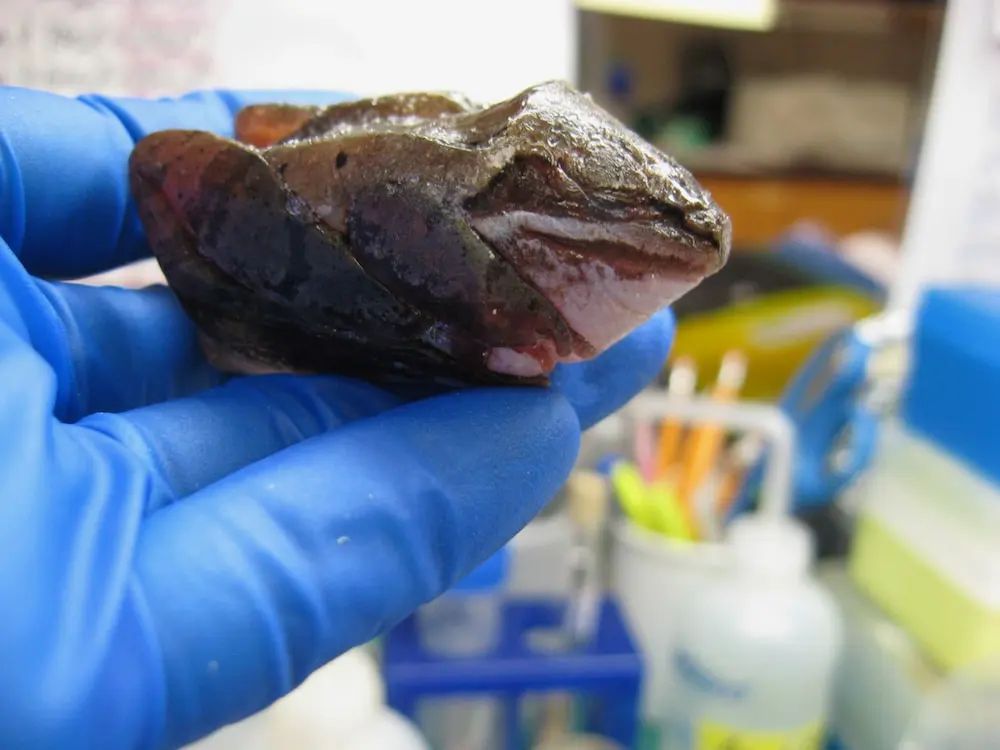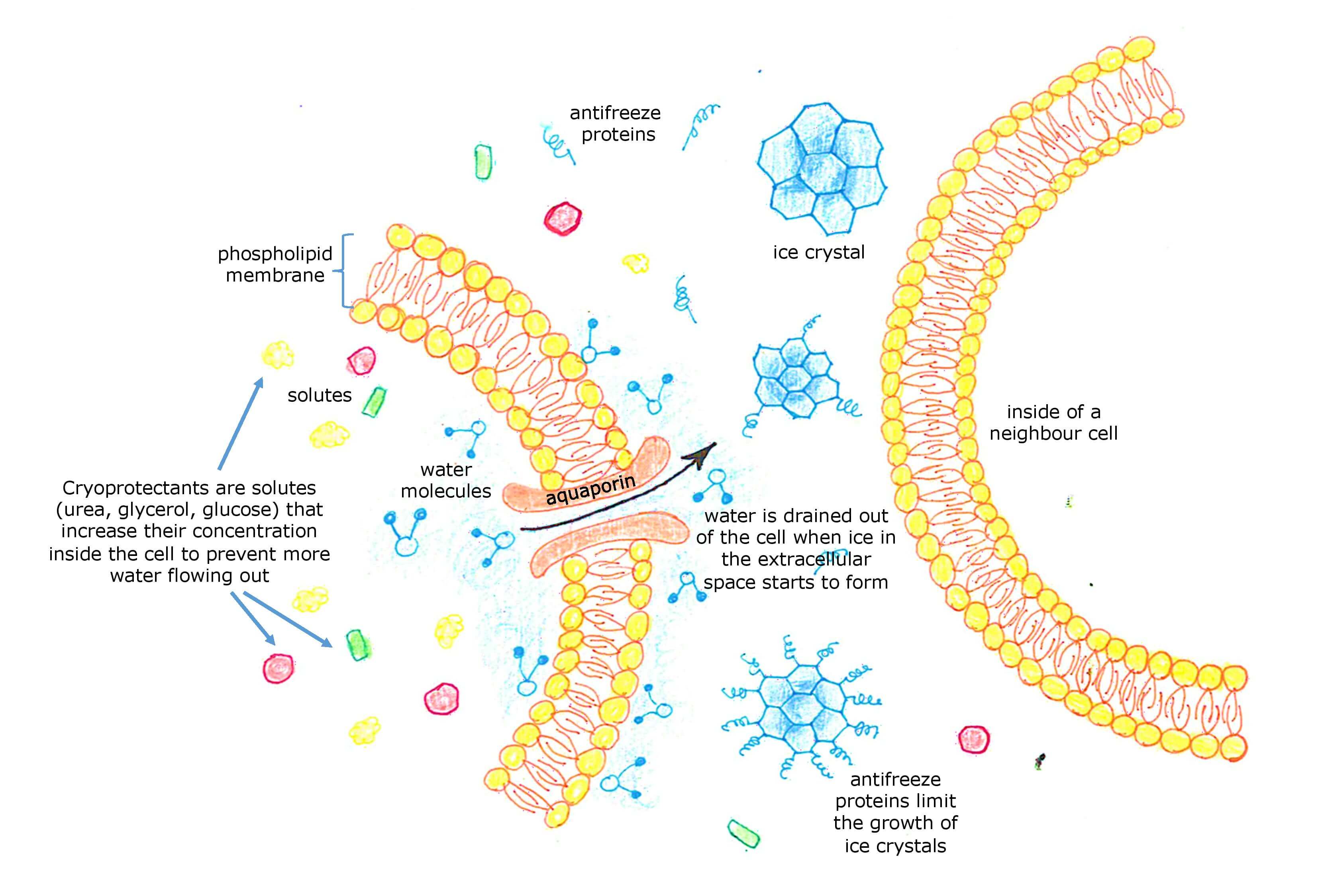
Credit: Clara do Amaral, Mount St. Joseph University, Cincinnati, Ohio
Many animals hibernate, but only the wood frog can freeze solid in winter—its heart and brain stopping completely—then thaw and come back to life in the spring.
Its process to do this is fascinating … and could one day save human lives.
The danger with freezing is ice. If water freezes within a cell, sharp ice crystals will puncture or rupture cell walls and kill the cell, which normally kills the animal.
So, as temperatures drop, the wood frog’s liver converts glycogen to glucose, a sugar syrup, and floods the frog’s system.
Meanwhile, nucleating proteins push water from the frog’s cells. Glucose replaces the water, which keeps the cells from freezing.
Outside the cells, the water does freeze, which stops the frog’s metabolism, including its brain and heart, and preserves its tissues.
In spring, the frog thaws, its brain and organs come back to life, and breeding season begins.
Several other animals use chemical antifreezes to avoid ice crystals forming within their cells.
And now researchers are trying to do the same with human organs harvested for transplant. Organs currently remain viable for only a few hours outside the body.
But if glucose could replace the water within them, perhaps they too could be frozen solid and later reanimated, greatly prolonging transplant time.
A potentially life-saving technique for humans, learned from the humble wood frog.
Background
Synopsis: We’ve talked about hibernation on prior episodes, but some animals, rather than entering a deep sleep, freeze solid over winter, then miraculously come back to life in the spring. Their secret is sugars that act like antifreeze, preventing the water molecules in their cells from forming ice crystals which leads to cell death. This method of preservation is being studied to try to prolong the lifespan of organs for transplant while outside of the human body, by freezing then reanimating them.
- Hibernation, as mentioned in ED-244 Not a Creature Was Stirring, is a state animals enter during the winter, slowing their metabolism and other bodily functions to conserve energy.
- Warm-blooded animals may hibernate by going into suspended animation, with their body temperatures and heart rate dropping as they survive on fat stores.
- Amphibians go into brumation, hibernation for cold-blooded animals, to avoid winter altogether. They do this by burying themselves in mud or diving very deep underwater, to insulate themselves against the harsh weather and temperatures.
- During hibernation or brumation, normally animals do not freeze. However, there are a few species that can, including certain insects and reptiles, along with one mammal.
- Rather than trying to insulate themselves from the winter cold like most amphibians, wood frogs (Lithobates sylvaticus) can freeze solid.
- Normally, when water in blood and tissues freezes, ice crystals form inside the cells causing them to rupture or be punctured, killing the animal. But wood frogs are adapted to withstand freezing.
- Before the frogs freeze, dropping temperatures stimulate the liver of the wood frog to start producing large amounts of glucose, a syrupy sugar that acts as a natural antifreeze.
- Nucleating proteins help with this antifreeze action, pushing water out of the cells, where it can more safely freeze. Within the cell, glucose replaces that water, stopping cell death.

Prevention of freezing by forming a natural antifreeze solution in cells.
Credit: Anja Soklič, adapted after Joelle Bolt, Freezing cells, 2013, via| BlogIONIK - When the water around the frogs’ cells freezes, it causes their brains and hearts to stop, while the cells themselves remain alive, waiting for the water around them to thaw.
- When the frogs defrost and wake from their Captain America-style cryosleep in spring, mating season begins.

A frozen wood frog in its natural habitat.
Credit: Jan Storey, National Science Foundation, via Nature Center at Shaker Lakes
- Scientists think the reason for this amazing adaptation is to expand the wood frog’s habitat, making it the only amphibian that lives north of the Arctic Circle.
- Wood frogs in different areas can survive temperatures as low as -16°C (~3°F). Alaskan frogs have an even larger amount of glycogen in their livers that gets converted into glucose, compared to their Ohioan and Alabamian counterparts. Their blood plasma also contains more urea, another antifreeze compound.
- Winter temperatures in Alaska can fluctuate enough that wood frogs freeze overnight and thaw in the mornings.
- Dr. Don Larson from the University of Alaska, a scientist who performed live experiments on captive and wild wood frogs, argues that their continuous flash freezing and thawing may help build further resistance around cells to the colder temperatures, and stimulate more glucose production.

Wood frog habitats in North America.
Credit: Costanzo et al. (2013) via Nature Center at Shaker Lakes
- However, the wood frog isn’t the only animal that can withstand the deadly cold. There are others that do so using different methods.
- In a previous episode, ED-195 Why Fish Don’t Freeze, we talked about how fish can survive winters in freezing lakes and ponds using a similar mechanism.
- Alligators in cold climates point their muzzle above the water as the surface freezes, allowing the water below to keep their body warm enough. They will stay locked in the frozen pond until temperatures warm.
- Darkling Beetles use a different sugar-based antifreeze, xylomannan, combined with oily compounds in their bodies, to stop ice from forming in their cells.
- The Antarctic Midge can survive temperatures down to 5°F (-15°C) by dehydrating itself and producing antifreeze-like proteins in its blood, as we described in ED-294 Antarctica’s Largest Land Creature.
- The microRNA in painted turtle hatchlings reorganizes their metabolism as they freeze, giving them a similar defense against the cold as wood frogs, but consuming much less glucose.
- The one mammal that makes this list is the Arctic ground squirrel, whose body temperature can get down to -2.9°C (26.8°F). It survives by eliminating nuclei on which ice crystals can form. This is called supercooling, but it comes with the risk of accidental ice formation from an intruding nucleating agent or contact with an outside force.
- The wood frog’s method of freezing and reanimation using glucose is being studied by scientists to improve organ longevity and assist transplant banks with storage.
- Organs like the heart can only survive for four to six hours after being removed from the body. These few hours are vital to ensure a transplant goes well and the receiving patient is saved from further complications.
- However, if transplant banks could freeze organs using glucose to prevent cell death, organs could be preserved for much longer, then successfully transplanted and reanimated.

